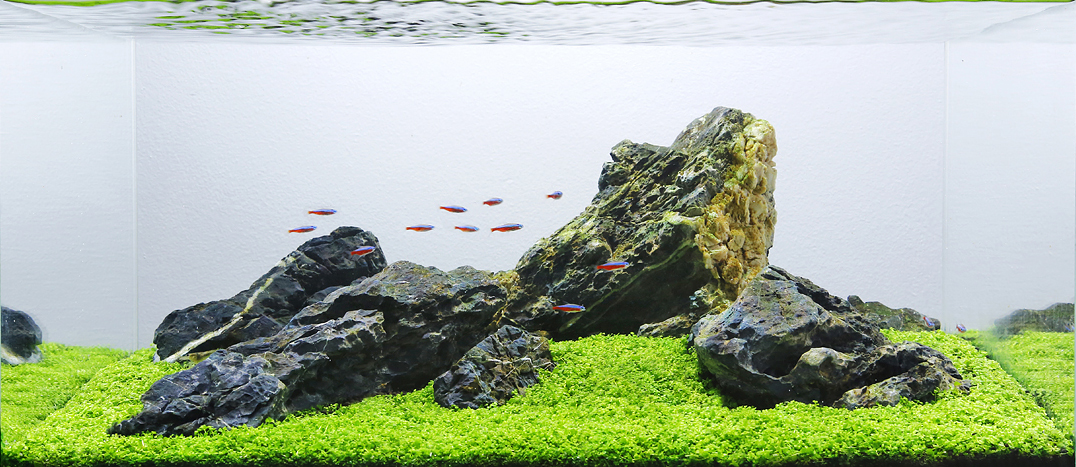
While we wait for the pictures of the the IAPLC 2011 winners to be released, I thought it would interesting for you if I analyzed last year's winning aquascape. The winner was chosen by a group of international aquascaping experts and, as such, I am by no means questioning their conclusions as to the ranking of this aquascape. I am merely applying established design principles and guides to it and sprinkling in some of my experience with aquascaping. So, with that, lets take a look at Forest Scent by Pavel Bautin (Russia) and see what we can learn from it. What we're trying to understand is why this aquascape is so good that it won the competition.
Rule of Thirds

Lets begin by looking at the aquascape using the most common design principle, the rule of thirds. We divide the scape into thirds and see if the key elements land on these lines and sections.
As you can see above, Pavel does a pretty good job of positioning one focal item right on a third line- the large tree on the right. The middle section is somewhat less full than the left or right sections. Most of the foreground and middle ground lie in the bottom two thirds with open space in the top third only slightly encumbered by the background tree tops. Most of the foreground lies in the bottom third.
Overall, I think Pavel does a good job of positioning the aquascape for a strong, anchored arrangement. Do you think he used the rule of thirds consciously when setting up and trimming?
Golden Section

The golden section is similar to the rule of thirds but if tries to see where the focal point falls. Ideally, you want to have focal points that are not directly in the middle of your aquascape either horizontally or vertically. Here, what I interpret to be a focal point is the big tree on the right. Pavel uses that plus a build up of trees in the right section to give your eye the impression that there's a heavier concentration of trees there. It fits nicely in the right section as you can see above.

I also like how Pavel uses the upper two sections to divide the foreground from the rest of the composition. The above image really highlights this effect that we all know if needed but that putting it to good use is easier said than done.
Golden Spiral

The golden spiral principle attempts to see if the focal point of the composition is in a place where traditionally a composition is strong to humans. There's a lot of math behind this that I won't get into here but just accept, for now, that we feel an arrangement is well done if the focal point lies within the golden spiral.
Here, Pavel hits the nail on the head. As I mentioned above, I think the focal point is that big tree on the right. The golden spiral confirms my suspicions. Do you also get that feels of that tree anchoring the overall aquascape?

Lets not forget to look at the left side. There seems to be a secondary focal point here. It's the smaller tree on the left. It's secondary because the tree is thinner than the one on the right. If Pavel would have placed a bigger tree here, it would have thrown the composition out of balance as there would be two competing focal points.
I am intrigued that the spiral falls right on the lines of two thin trees that Pavel placed. Notice the highlighted section. I am not sure of the placement of the right thin tree so far in the foreground but I talk more about it later.
Harmonious and Harmonic Triangles

We humans love triangles and so does nature. Triangles in compositions speak subconsciously to our souls. They make the composition look and feel natural to us. Lets see how Pavel does in this department.
The harmonious triangles, pictured above, clearly show that Pavel chose to have a top and bottom triangle composition. However, notice that there are also more hidden triangles on the left and right. This makes for a strong composition that feels natural and right to us.
Again, do you think he did it consciously?

Above is a more simplistic triangle arrangement that looks only to harmonic triangles. Don't just focus on the obvious four triangles. Notice also the triangles that take up half the composition on the left and right (the side and bottom triangles). Triangles can be subtle but your soul sees them and they make the aquascape feel natural.
This is not easy to do. You can go overboard with triangles and turn a natural aquascape into a more manicured human one like an English garden. It's beautiful but obviously man-made. It's an art to use triangles in a natural way and Pavel does an excellent job here.
The image below highlights to two main triangles. However, as I mentioned, there are many subtle, hidden triangles your subconscious picks up on.

Perspective
Perspective is hugely important when you're working within the confines of four glass walls. It's important to make your aquascape seem larger than it really is. This is especially important in a nature aquarium style because it must convey a sense of an expansive, natural setting. Lets explore how Pavel sets up perspective in his composition and makes it look bigger than it really is. Can you tell what size aquarium this is?

Simplistically, perspective is created by changing the size of elements. Notice the trees on the left above. I've highlighted them to make it easier to tell the difference in size between them. Notice that the closer tree is bigger and taller. The one in the back is clearly thinner and shorter. There's only inches between them in reality but to our eye and mind, they could be a great distance apart.
This feeling is accentuated by the small plants in the foreground that transition in size through the middle and then background. As you can see above, Pavel chose to focus on height as the key perspective generator when choosing plants. They get taller as you go back in the arrangement. You also tend to see expert aquascapers use color to turbo charge perspective. Pavel did not use much of that here. The middle-back line of plants are a brighter green than the plants just in front of them. This tends to want to stop the eye from moving back into the composition and I see it as a bit of a miss here. However, the brighter color also reminds you of tree canopies that tend to be lighter as you go higher so I'm a bit torn here.
What do you think?
As I mentioned before, I am unsure of the placement of that tall, thin tree in the front left of the composition. Why did Pavel feel it belonged there? It does fall on a focal spiral line as we discussed but does it add or distract from the perspective or balance of the aquascape? I'm not totally sure.
Through the magic of Photoshop, I've taken the liberty of removing it from the aquascape. Below is what the aquascape would look like without it. What do you think?
I think that it does, in fact, add to the balance of the aquascape overall. The fact that it is so thin and almost imperceptible means that perspective is not totally sacrificed in an attempt to balance the composition. Well done, Pavel. Your mastery of that subtle element is impressive.

Nature Approximation

In the IAPLC, especially over the last few years, an aquascape must approximate nature to rank highly. In natural aquariums like these, I think this is critical. The whole concept of the nature aquarium is getting inspiration from nature and creating an idyllic version of it in your aquarium. This is where Pavel's aquarium separates from the pack.
I mean, wow, can anyone look at this aquascape and not feel like they're in the middle of a beautiful forest somewhere? All of the details and positioning of elements fade into the background and what really hits you is the overall feel of nature. My soul tells me immediately that this is a place I'd like to spend time in and I long for.
Truly excellent focus on details only adds to this feeling. Pavel's choice of wood for the trees is very well done. They look like they've been there for years. They all have the same color and feel. Even the wood pieces on the ground are covered with the foreground plants giving the impression of timelessness and antiquity.
This is an inspiration to all of us.
Overall Impression
Finally, taking into account everything I mention above, I think Pavel clearly deserves his world ranking as the grand prize winner. Even the name, Forest Scent, perfectly adds to what this aquascape is and the feel it creates.
Although I've taken you through a deconstruction of Forest Scent, like reading a book to understand why it was written the way it was, please step back and take in Forest Scent for what it is – a beautiful expression of nature and what we all long for as human beings.
Well done, Pavel, and thank you.
All the best






7 Comments on “Analysis of 2010 IAPLC Winner”
Pingback: Anonymous
I think your analysis of Forrest Scent is spot on, well done!
With regard to the larger tree in the left quadrant, I think it is a necessary component along with it's partner on the near right to create a doorway effect. These two are the nave if you will, to the interior of the forest "chapel."
I just finished watching a series on architecture in art, so the church model made sense to me. I have also been accused in my photography classes of forcing the viewer to look through a "window" or caged perspective. Guilty as charged.
Thanks for the excellent analysis on forced perspective, now I do not have to do it and will be linking to your treatment in a future blog post.
Pingback: 75g assistance. - Page 2
Pingback: Tharsis' 75G Stumptastic Natural Dutch ~10-02-11~ - Page 13
Pingback: Great Aquascaping Article at Scapefu.com
Hi there! Thanks a lot for this wonderful information! I learned new materials on this article. If you don’t mind, I would like to add this post on my website and send a link to your site 🙂
Pingback: These Custom Aquariums with Underwater Trees will Blow Your Mind! - Okeanos Aquascaping - Freshwater Aquascapes with Underwater Trees and Forests